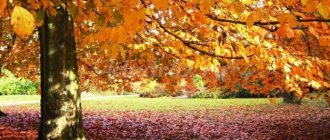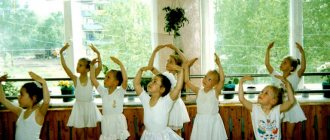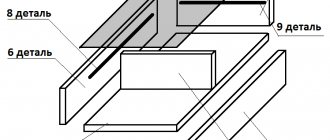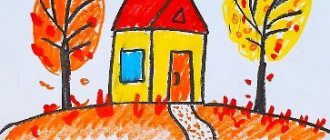Preview:
Municipal autonomous preschool educational institution
city of Naberezhnye Chelny “Combined kindergarten No. 23 “Firefly”
Summary of a drawing lesson in the preparatory group
Naberezhnye Chelny, 2016.
Arouse children's interest in late autumn, mosses growing on trees, stones, and forests, and develop the ability to be emotionally distracted by the mood of sadness conveyed in poetry. Arouse the desire to express this state with the help of color in a landscape drawing.
- practice naming autumn signs to enrich children’s vocabulary;
- form ideas about neutral colors (black, white, dark gray, light gray, brown), use these colors when creating paintings of late autumn;
- develop the ability to independently convey in a drawing the landscape of late autumn, its color (the absence of bright colors in nature);
- practice the ability to draw trees of different structures and bushes without leaves, draw growing moss on trees, stones and ground;
- consolidate drawing techniques with the end of the brush;
-continue to develop the ability to feel, understand and reproduce the imagery of the language of a poem;
- develop coordination of movements, accompanying speech;
— develop fine motor skills through finger play;
- cultivate a love for poetry and native nature;
- cultivate an aesthetic perception of nature;
— to cultivate in children an interest in drawings, a desire to look at and talk about them.
Sample made by the teacher. Landscape sheets of paper, watercolors, palette, brushes.
Reading poems by Russian poets about autumn by A. N. Pleshcheev, A. S. Pushkin, and others.
Memorizing poems about autumn “Autumn” by M. Khodyakov and “The Swallows Are Missing” by A. Fet. Poems about mosses.
A conversation about late autumn and its signs.
Examination of reproductions of paintings by famous artists in the presentation “Late Autumn through the Eyes of Artists.” Presentations about mosses.
Examination of illustrations, pictures, reproductions.
Observations (of the sky; trees; growing mosses: on trees, foundations, ground; rain; snow) while walking.
— Guys, what time of year is it now?
— What autumn months do you know? What month is it? November is the last month of autumn.
- Listen to A. Pleshcheev’s poem, what autumn is the poet talking about?
Withers and turns yellow
Grass in the meadows
A cloud covers the sky
The sun doesn't shine
The wind howls in the field,
—Are you happy about this picture painted by the poet?
— What signs of late autumn does Pleshcheev talk about in the poem?
- Indeed, the poem talks about a dull, gloomy, cold autumn. The leaves have fallen off the trees, the grasses wither and turn yellow, the bushes are dull and bare, the flowers have dried up, the birds have flown to warmer climes, and it often drizzles.
— Autumn is like the evening of the year. And in the evening we get ready for bed. So the trees took off their clothes and washed themselves with the rain. Wildlife falls asleep. Late, gloomy autumn has arrived. In late autumn there are often cold drizzling rains, sometimes snow or sleet, the trees shed their last leaves, the grass has dried up, the flowers have withered. The last birds fly south. Animals are preparing for winter, people put on warm clothes, moss continues to grow as it grows on trees, foundations, and the ground.
— The rain is knocking on our windows and inviting us to play.
A drop once a drop two. (Children perform jumps on two legs)
Very slowly at first, (Holding hands, children walk in a circle)
And then, then, then
Everybody run, run, run. (Walking in a circle with acceleration)
We opened our umbrellas, (We make a dome over our heads with our hands)
Sheltered herself from the rain. (Squat down)
- Today I invite you to draw late autumn. What colors will you need for this - warm, bright or cold, gray?
— Look at the picture depicting late autumn. What color is the sky? - What trees?
— What signs of autumn are depicted? (light snow, gloomy sky, there are no leaves on the trees, but moss grows on the trunk and branches on stones and ground).
— Now I’ll tell you how to get these dim colors. You have palettes on your tables; artists use these palettes to compose paints. And you, like real artists, will do this.
— What paint do we need to mix to get gray paint? (add a drop of black to white paint).
— Yes, to get gray paint you need to add a little black paint to the white one. If you are painting clouds, then take blue paint and add a little black and white paint to it, mix them on the palette. The color of leaves and grass in late autumn also lost its brightness - it is brown. Take green paint and add a little yellow and brown to it - you get a brown color.
- So, first you need to make up the desired paint on the palette, and then draw with it on the sheet.
How to draw a tree: creative tasks for children
— What two groups are tree species divided into? (deciduous and coniferous)
- Name the species of deciduous trees (Rowan, aspen, poplar, linden, elm, autumn, maple, birch and others).
-What tree did you depict? Think about whether it is possible to depict coniferous trees using this technique?
— Try to draw a pine tree using this technique? How can I do that? ().
- Consider the shape of the tree. Are the crown and trunk dimensions the same at the top and bottom? What is the difference? How can you get this result when drawing a tree?
— Why is autumn called golden?
— Read to children or learn poems about autumn:
If the leaves on the trees have turned yellow, If the birds have flown to a distant land, If the sky is gloomy, if the rain is pouring, This time of year is called autumn. (M. Khodyakova “Autumn”)
Following summer, Autumn comes. The wind sings yellow songs to her, lays red leaves under her feet, flies like a white snowflake into the blue. (V. Stepanov “Autumn is Coming”)
An autumn tree can be drawn not only using the “poke” method, but also using other techniques. How to do this is in the step-by-step master classes below.
Autumn in watercolor
In order to paint an autumn picture in watercolor, you can start the creative process with a pencil sketch. With light lines you can outline the perspective, the horizon line and the alley framed by trees and stretching into the distance.
To work you need to prepare:
- landscape sheet or watercolor paper,
- paints,
- pencil,
- brush,
- a glass of water.
Operating procedure.
- Outline the main lines of the future drawing with a simple pencil. For convenience, you can draw the details in more detail.
- Below the horizon line, paint the background gray, applying the helmet with uneven strokes. The middle of the picture should be lighter.
- Draw the distant plan in a dark color, indicating the forest area. There is no need to draw details, simulating a limited view due to autumn fog.
- Use black paint to paint the tree trunks framing the alley stretching into the distance.
- The further the trees are from the observer, the lower and less clearly drawn they are.
- Apply strokes of yellow paint to outline the tree crown.
- After the drawing has dried, use light strokes to indicate the reflection of the trees on the wet asphalt of the alley.
The autumn theme for drawings is very diverse and is an inexhaustible source of inspiration. You can embody an artistic idea using paints, colored or simple pencils. Basic drawing techniques will help bring creative ideas to life.
Progress of the lesson.
Guys, listen to A. Pleshcheev’s poem and think about what autumn season the author is talking about :
The rain keeps pouring down
Gets wet under the window
Are you happy from this picture painted by the poet ?
-That’s how different autumn ! Either bright, elegant, or quiet, sad, grey. Today we will draw such an autumn . What colors will you need for this - warm, bright or cold, gray?
-Look at the picture depicting late autumn . what color is the sky? - What are the trees like?
Now I will tell you how to get these soft colors. You have palettes on your tables; artists use these palettes to compose paints. And you will do it. To get gray paint you need to add a little black paint to white. If you paint clouds , then take blue paint and add a little black and white paint to it, stir them on the palette. The color of the grass in late autumn also lost its brightness - it is brown. Take green paint and add a little yellow and brown to it - you get a brown color.
- so, first you need to put the right paint on the palette, and then draw it on a sheet . Think about your painting and get to work.
After finishing the drawing, the works are displayed for viewing.
Work plan for the non-traditional drawing circle “Magic Pencil” Name and goals of the lesson:[/u] 1. Let’s get to know each other! – I am Queen Brush Goals: Journey to the land of colors To instill a love of creative activity.
The program of the circle for artistic activities in non-traditional techniques “Gnome Workshop” Perspective-thematic plan Lesson topic Objectives Material Month October “Parents meeting” To acquaint parents with the specifics of the work of the circle about the types of fine arts.
Source
On the topic: methodological developments, presentations and notes
GCD for drawing in the preparatory group Non-traditional drawing.
Develop the idea that through the selection of colors you can convey in a drawing certain weather and mood characteristic of rainy late autumn. Introduce children to a new way of expression.
This type of activity was created taking into account the use of the “Childhood” program.
Arouse children's interest in late autumn, mosses growing on trees, stones, and forests, and develop the ability to be emotionally distracted by the mood of sadness conveyed in poetry. Call
Program content: learn to understand how composers, poets, artists, using different means of expression (color, composition, rhythm), convey the image of autumn; develop the ability to collectively
Summary of a drawing lesson in the preparatory group. Still life "Autumn gifts".
It is known that drawing is one of the most favorite children's activities, which cultivates many positive qualities in a child, such as perseverance and patience, attentiveness, imagination, and ability.




